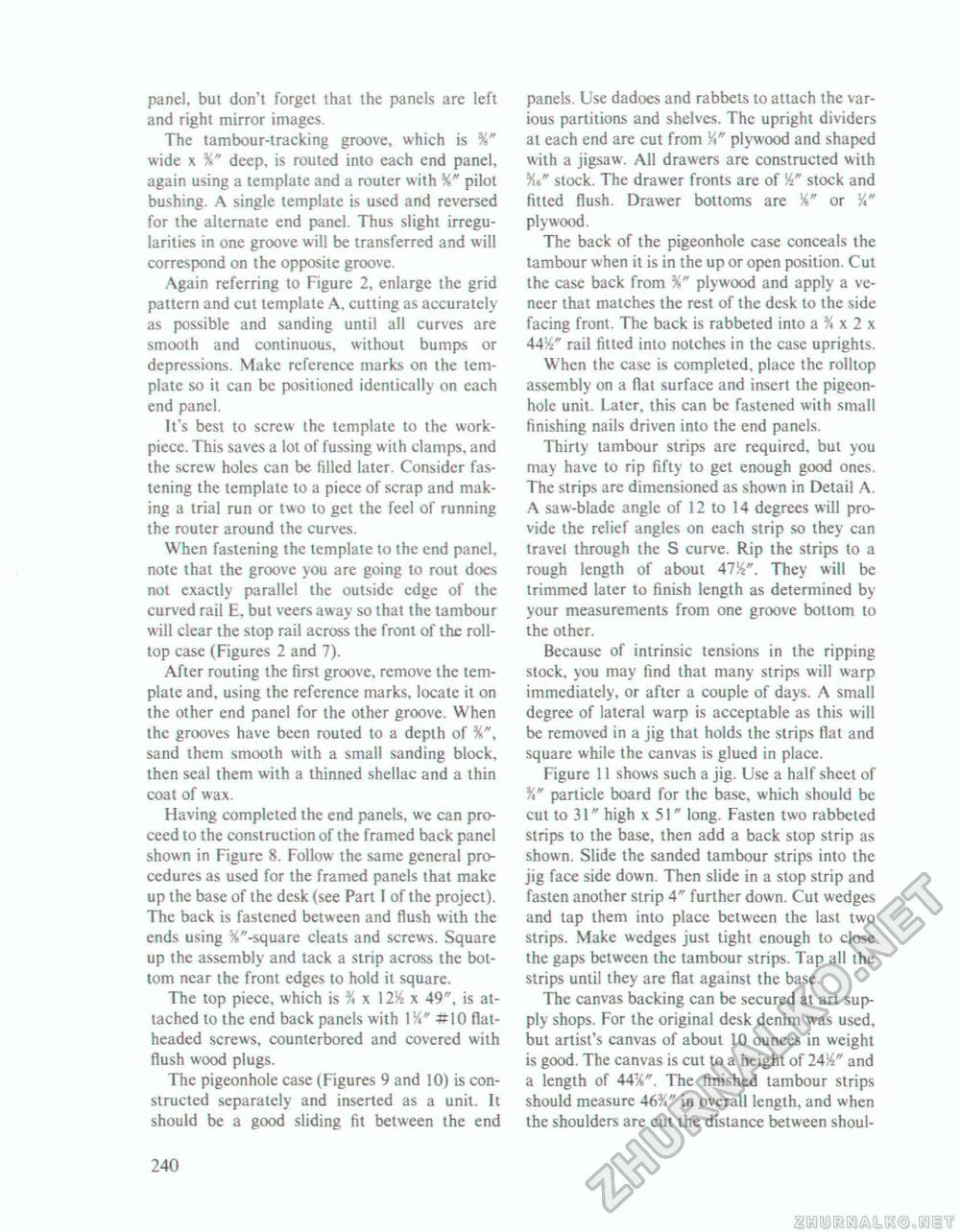Woodworker's Journal 101-Projects-for-Woodworkers, страница 247
panel, but don't forget that the panels are left and right mirror images. The tambour-tracking groove, which is %" wide \ %" deep, is routed into each end panel, again using a template and a router with %" pilot bushing. A single template is used and reversed for the alternate end panel. Thus slight irregularities in one groove will be transferred and will correspond on the opposite groove. Again referring to Figure 2, enlarge the grid pattern and cut template A. cutting as accurately as possible and sanding until all curves are smooth and continuous, without bumps or depressions. Make reference marks on the template so it can be positioned identically on cach end panel. It's best to screw the template to the work-piece. This saves a lot of fussing with clamps, and the screw holes can be filled later. Consider fastening the template to a piece of scrap and making a trial run or two to get the feel of running the router around the curves. When fastening the template to the end panel, note that the groove you are going to rout does not exactly parallel the outside edge of the curved rail E, but veers away so that the tambour will clear the stop rail across the front of the roll-top case (Figures 2 and 7). After routing the first groove, remove the template and, using the reference marks, locate it on the other end panel for the other groove. When the grooves have been routed to a depth of sand them smooth with a small sanding block, then seal them with a thinned shellac and a thin coat of wax. Having completed the end panels, we can proceed to the construction of the framed back panel shown in Figure 8. Follow the same general procedures as used for the framed panels that make up the base of the desk (see Part I of the project). The back is fastened between and flush with the ends using % "-square cleats and screws. Square up the assembly and tack a strip across the bottom near the front edges to hold it square. The top piece, which is % x IVA x 49", is attached to the end back panels w*ith IX" #10 flat-headed screws, counterbored and covered with flush wood plugs. The pigeonhole case (Figures 9 and 10) is constructed separately and inserted as a unit. It should be a good sliding fit between the end panels. Use dadoes and rabbets to attach the various partitions and shelves. The upright dividers at each end are cut from X" plywood and shaped with a jigsaw. All drawers are constructed with stock. The drawer fronts are of W stock and fitted flush. Drawer bottoms are %" or X" plywood. The back of the pigeonhole case conceals the tambour when it is in the up or open position. Cut the case back from %" plywood and apply a veneer that matches the rest of the desk to the side facing front. The back is rabbeted into a % x 2 x 4414'" rail fitted into notches in the case uprights. When the case is completed, place the rolltop assembly on a flat surface and insert the pigeonhole unit. Later, this can be fastened with small finishing nails driven into the end panels. Thirty tambour strips are required, but you may have to rip fifty to get enough good ones. The strips are dimensioned as shown in Detail A. A saw-blade angle of 12 to 14 degrees will provide the relief angles on each strip so they can travel through the S curve. Rip the strips to a rough length of about 47They will be trimmed later to finish length as determined by your measurements from one groove bottom to the other. Because of intrinsic tensions in the ripping stock, you may find that many strips will warp immediately, or after a couple of days. A small degree of lateral warp is acceptable as this will be removed in a jig that holds the strips flat and square while the canvas is glued in place. Figure 11 shows such a jig. Use a half sheet of particle board for the base, which should be cut to 31" high x 51" long. Fasten two rabbeted strips to the base, then add a back stop strip as shown. Slide the sanded tambour strips into the jig face side down. Then slide in a stop strip and fasten another strip 4" further down. Cut wedges and tap them into place between the last two strips. Make wedges just tight enough to close the gaps between the tambour strips. Tap ail the strips until they are flat against the base. The canvas backing can be secured at art supply shops. For the original desk denim was used, but artist's canvas of about 10 ounces in weight is good. The canvas is cut to a height of 2414" and a length of 44%". The finished tambour strips should measure 46%" in overall length, and when the shoulders are cut the distance between shoul 240 |








